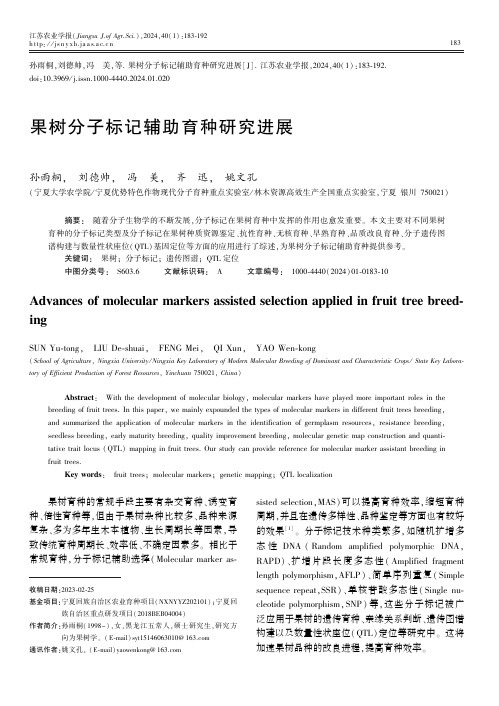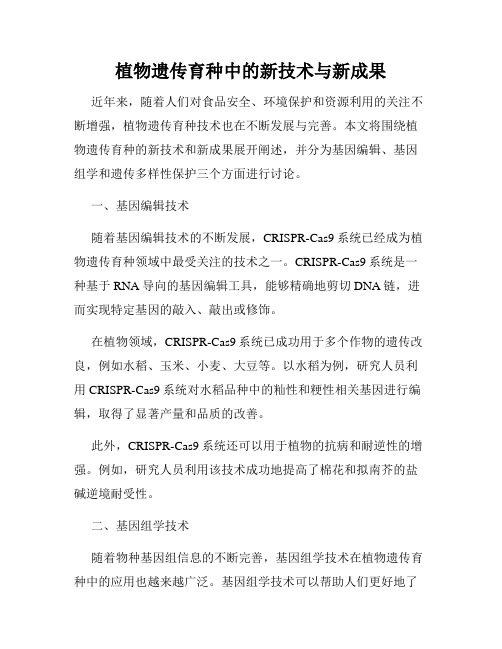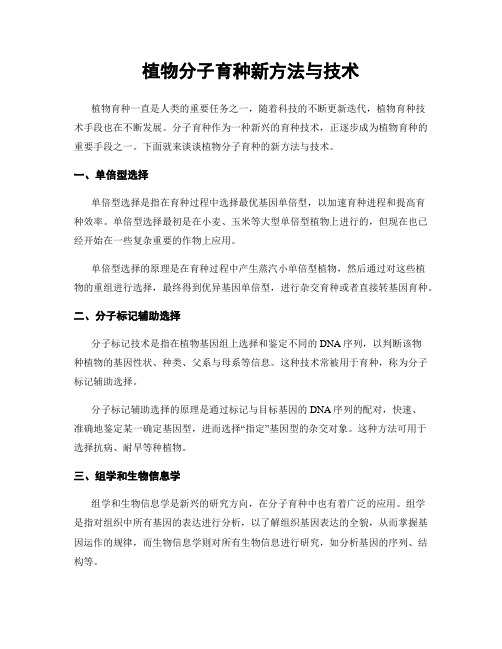国际植物分子育种最新研究进展
植物分子育种技术及应用

植物分子育种技术及应用随着人口的不断增长,越来越多的粮食和其他农作物需求不断增长。
而传统的育种方法需要大量的时间和成本,不能满足现代社会的需求。
为此,科学家们研究出了一种名为植物分子育种技术的新方法。
本文将介绍这种新技术,并探讨它的应用前景。
1. 植物分子育种技术是什么植物分子育种技术是一种基于分子生物学和生物信息学的新兴技术。
它是通过分析植物基因组中与某些质量特征相关的DNA标记,来帮助育种者判断某个植株的质量特征。
这种技术不仅节省了传统育种方法中的时间和成本,而且能够更准确地预测育种结果。
2. 植物分子育种技术的应用由于植物分子育种技术具有高效、高准确性和高可操作性的优点,因此已经在许多农作物的育种中得到了广泛应用。
以下是这种技术应用的几个方面:(1)提高产量和品质植物分子育种技术可以通过种子培育、环境控制和育种研究等方法来提高作物的产量和品质。
例如,通过检测大豆DNA中的一些特定标记,科学家可以挑选出潜在的耐旱、高产和高蛋白质品种。
(2)提高抗病性植物分子育种技术还可以帮助育种者研究抗病性。
通过分析具有特定DNA标记的植物,科学家可以预测一些抗性基因在种群中的频率。
这一因素对于研发抗病新品种尤为重要。
(3)开发适应性更高的品种由于气候变化和其他环境变化的影响,许多种植物无法适应当地的气候和土地条件。
植物分子育种技术可以帮助开发适应性更高的品种。
通过分析多个DNA标记,科学家可以确定那些携带适应性基因的植物,进而培育出更适合当地环境的新品种。
3. 植物分子育种技术的实现和发展植物分子育种技术是一项复杂的研究领域,需要多学科领域的知识支持。
同时,这种技术也需要新的技术和新方法的不断开发。
(1)基因测序技术的进步随着基因测序技术的不断发展,植物分子育种技术也得到了更多的支持。
人们可以在更短的时间内完成基因测序,同时也可以分析更多的DNA标记,从而提高了植物分子育种技术的准确性和效率。
(2)人工智能和大数据的应用人工智能和大数据对于植物分子育种技术的应用尤为重要。
植物分子育种的研究与发展

植物分子育种的研究与发展植物育种是指通过人工或自然的方式,对植物进行基因交换、选良选优、杂交改良等操作,进而获得更为优良的植物品种,以满足人们农业生产、食品生产等方面的需求。
而植物分子育种作为一种新兴的育种手段,在近年来得到了越来越广泛的应用,其研究与发展也逐渐受到了人们的关注。
一、植物分子育种的定义及发展历程植物分子育种是指以分子水平对植物的遗传因子进行研究和操纵,通过利用现代分子生物学技术,探索和开发新的植物育种方法。
该技术自20世纪60年代起,在基因工程和生物技术的推动下发展迅速,直到今日已成为植物育种领域的一大热点。
早在1972年,在分离了第一条限制性内切酶EcoRI基因序列之后,植物分子育种就诞生了。
1983年,瑞士科学家哥隆等人成功地将牛转移成一株含人成纤维细胞基因组DNA的细胞株,此举不仅为人类基因组研究奠定了基础,也为植物分子育种的未来发展铺平了道路。
不久之后,植物基因工程和生物技术迅速发展,其中包括基因克隆、基因编辑、基因组测序等技术的问世,加速了植物分子育种的发展。
因此,植物分子育种得以拓展各个领域,包括植物遗传学、植物育种、植物病理学和分子生态学等。
二、植物分子育种的方法与技术通过利用现代分析技术,如核酸测序、基因检测、基因编辑等,检测和操作目标基因,从而实现对植物基因的操纵。
在植物分子育种研究中,主要采用的方法包括:1.基因编辑技术随着CRISPR-Cas9的发明和改进,基因编辑技术已经成为目前最热门的植物分子育种技术之一。
利用基因编辑技术可以直接在植物体内修饰目标基因,快速成功改良植物性状。
2.遗传改造技术遗传改造技术是将外源基因整合到植物基因组中,以直接调控植物性状。
这种技术可用于改变植物抗病性、免疫能力、营养价值、生长速度和产量等。
3.转录组分析技术基于分子生物学方法,新一代测序技术的应用和全基因组测序数据的广泛拓展,植物转录组分析技术发展迅速。
通过转录组分析技术,可以对植物的基因表达进行深入的研究,理解植物生长发育中的分子机制。
植物分子生物学和基因工程的研究进展

植物分子生物学和基因工程的研究进展随着科学技术的不断进步,植物分子生物学和基因工程的研究逐渐走向深入,为解决各种现实问题、改善人类生活做出了巨大的贡献。
一、植物分子生物学的发展植物分子生物学是研究植物的基因、DNA、RNA、蛋白质及其相互作用等分子水平的学科。
对于人类来说,在人类农业中发挥着不可或缺的作用,它可以帮助我们更好地改善农业生产、保护环境,提高食品质量。
1. 转基因技术的广泛应用转基因技术,也称遗传工程技术,是通过对植物DNA的操作使其产生一些特殊的性状,实现对植物生长过程的控制和改变。
转基因技术已经被广泛应用于植物栽培中,例如通过调整作物免疫系统提高作物抗病能力,提高粮食产量和食品品质。
另外,还能通过改变植物细胞壁的结构,提高其对重金属和化学污染的抵抗力,使不适宜栽培的荒芜土地变成可耕作土地。
2. 分子标记技术的应用分子标记技术是指通过分别在基因上添加特定的标记,利用分子生物学方法研究基因分布和发育等相关问题。
随着施肥技术和农艺水平的提高,现代农业对于植物吸收和利用养分的高效率越来越高,而分子标记技术为实现这一目标提供了可能。
二、基因工程的发展基因工程是指通过改变或替换植物基因,使其具有改变植物性状的能力。
基因工程目前在医学、农业领域得到了广泛的应用,尤其是在育种和疾病治疗方面有着重要的意义。
1. 基因剪切技术的突破基因剪切技术是指通过人工干预植物中RNA的剪接,改变mRNA的结构、组成和功能,从而诱导植物产生特殊的基因表达状态。
这种技术通常用于通过改变性状来增加植物抗性、增强植物光合作用、提高产量等目的。
2. 代谢工程技术的革新代谢工程技术是指通过基因表达在植物中产生新的代谢途径,从而获得新的代谢产物。
代谢工程技术的革新能够帮助我们生产更多、更高质量的产品,如高紫根素、萜类化合物等。
总之,植物分子生物学和基因工程的研究是一个充满活力、充满生机的领域,它所取得的进展,不仅能够改善人类生活,也能对抗各种环境污染和疾病造成的威胁。
果树分子标记辅助育种研究进展

江苏农业学报(JiangsuJ.ofAgr.Sci.)ꎬ2024ꎬ40(1):183 ̄192http://jsnyxb.jaas.ac.cn孙雨桐ꎬ刘德帅ꎬ冯㊀美ꎬ等.果树分子标记辅助育种研究进展[J].江苏农业学报ꎬ2024ꎬ40(1):183 ̄192.doi:10.3969/j.issn.1000 ̄4440.2024.01.020果树分子标记辅助育种研究进展孙雨桐ꎬ㊀刘德帅ꎬ㊀冯㊀美ꎬ㊀齐㊀迅ꎬ㊀姚文孔(宁夏大学农学院/宁夏优势特色作物现代分子育种重点实验室/林木资源高效生产全国重点实验室ꎬ宁夏银川750021)收稿日期:2023 ̄02 ̄25基金项目:宁夏回族自治区农业育种项目(NXNYYZ202101)ꎻ宁夏回族自治区重点研发项目(2018BEB04004)作者简介:孙雨桐(1998-)ꎬ女ꎬ黑龙江五常人ꎬ硕士研究生ꎬ研究方向为果树学ꎮ(E ̄mail)syt15146063010@163.com通讯作者:姚文孔ꎬ(E ̄mail)yaowenkong@163.com㊀㊀摘要:㊀随着分子生物学的不断发展ꎬ分子标记在果树育种中发挥的作用也愈发重要ꎮ本文主要对不同果树育种的分子标记类型及分子标记在果树种质资源鉴定㊁抗性育种㊁无核育种㊁早熟育种㊁品质改良育种㊁分子遗传图谱构建与数量性状座位(QTL)基因定位等方面的应用进行了综述ꎬ为果树分子标记辅助育种提供参考ꎮ关键词:㊀果树ꎻ分子标记ꎻ遗传图谱ꎻQTL定位中图分类号:㊀S603.6㊀㊀㊀文献标识码:㊀A㊀㊀㊀文章编号:㊀1000 ̄4440(2024)01 ̄0183 ̄10Advancesofmolecularmarkersassistedselectionappliedinfruittreebreed ̄ingSUNYu ̄tongꎬ㊀LIUDe ̄shuaiꎬ㊀FENGMeiꎬ㊀QIXunꎬ㊀YAOWen ̄kong(SchoolofAgricultureꎬNingxiaUniversity/NingxiaKeyLaboratoryofModernMolecularBreedingofDominantandCharacteristicCrops/StateKeyLabora ̄toryofEfficientProductionofForestResourcesꎬYinchuan750021ꎬChina)㊀㊀Abstract:㊀Withthedevelopmentofmolecularbiologyꎬmolecularmarkershaveplayedmoreimportantrolesinthebreedingoffruittrees.Inthispaperꎬwemainlyexpoundedthetypesofmolecularmarkersindifferentfruittreesbreedingꎬandsummarizedtheapplicationofmolecularmarkersintheidentificationofgermplasmresourcesꎬresistancebreedingꎬseedlessbreedingꎬearlymaturitybreedingꎬqualityimprovementbreedingꎬmoleculargeneticmapconstructionandquanti ̄tativetraitlocus(QTL)mappinginfruittrees.Ourstudycanprovidereferenceformolecularmarkerassistantbreedinginfruittrees.Keywords:㊀fruittreesꎻmolecularmarkersꎻgeneticmappingꎻQTLlocalization㊀㊀果树育种的常规手段主要有杂交育种㊁诱变育种㊁倍性育种等ꎬ但由于果树杂种比较多㊁品种来源复杂㊁多为多年生木本植物㊁生长周期长等因素ꎬ导致传统育种周期长㊁效率低㊁不确定因素多ꎮ相比于常规育种ꎬ分子标记辅助选择(Molecularmarkeras ̄sistedselectionꎬMAS)可以提高育种效率ꎬ缩短育种周期ꎬ并且在遗传多样性㊁品种鉴定等方面也有较好的效果[1]ꎮ分子标记技术种类繁多ꎬ如随机扩增多态性DNA(RandomamplifiedpolymorphicDNAꎬRAPD)㊁扩增片段长度多态性(AmplifiedfragmentlengthpolymorphismꎬAFLP)㊁简单序列重复(SimplesequencerepeatꎬSSR)㊁单核苷酸多态性(Singlenu ̄cleotidepolymorphismꎬSNP)等ꎬ这些分子标记被广泛应用于果树的遗传育种㊁亲缘关系判断㊁遗传图谱构建以及数量性状座位(QTL)定位等研究中ꎮ这将加速果树品种的改良进程ꎬ提高育种效率ꎮ3811㊀果树上应用分子标记的主要类型1.1㊀RAPD分子标记为适应不良环境以及抵御病虫危害ꎬ培育具有一定抗性的果树品种至关重要ꎮTartarini[2]从5种不同的RAPD标记中筛选出与MdVf基因紧密相关的OPAM192200和OPAL07580ꎬ标记了苹果(Malusdo ̄mestica)抗赤霉病Vf基因ꎮ杨亚州等[3]以燕山葡萄和河岸葡萄的F1代为材料ꎬ通过7个RAPD标记对其抗旱性进行研究ꎬ将RAPD标记5226 ̄1100转化成专一性的SCAR(Sequencecharacterizedamplifiedregionsꎬ特定序列扩增)标记DR ̄760ꎮ其次RAPD分子标记多用于果树遗传多样性及品种鉴定ꎬ余智城等[4]对16份柑橘包括11份琯溪蜜柚进行遗传多样性分析ꎬ通过15条RAPD引物将16份材料分为2大类(表1)ꎮ表1㊀随机扩增多态性DNA(RAPD)分子标记在果树上的应用Table1㊀ApplicationofrandomamplifiedpolymorphicDNA(RAPD)molecularmarkersonfruittrees物种(属)功能主要结果参考文献苹果(MalusMill.)筛选抗病基因从5种不同的RAPD标记中筛选出与Vf基因紧密相关OPAM192200和OPAL07580标记苹果抗赤霉病Vf基因[2]葡萄(VitisL.)筛选抗旱基因以燕山葡萄和河岸葡萄的F1代为材料ꎬ通过7个RAPD标记对其抗旱性进行研究ꎬ获得了抗旱基因的RAPD标记[3]柑橘(CitrusL.)遗传多样性分析以16份柑橘包括11份琯溪蜜柚为材料用15条RAPD引物对其遗传多样性进行分析ꎬ将16份材料分为2大类[4]李(PrunusL.)绘制遗传图谱利用RFLP(限制性内切酶片段长度多态性)和RAPD标记绘制桃的遗传连锁图谱[5]品种鉴定使用360个RAPD引物进行大片段分析ꎬ以鉴定桃与桃㊁桃与杏仁杂交中特定位点相关的标记[6]遗传多样性分析用RAPD分子标记技术对7个樱桃品种进行多态性分析ꎬ将7个樱桃品种分为4类[7]杧果(MangiferaL.)遗传多样性分析从20个RAPD引物中筛选15个引物ꎬ分析了34份传统杧果种质的遗传变异和亲缘关系[8]1.2㊀AFLP分子标记分析果树遗传多样性ꎬ有助于果树的分类ꎮ董美超等[9]针对90份鳄梨品种材料从24对AFLP引物中筛选出8对进行遗传多样性分析ꎬ根据遗传相似系数可划分为4个类群ꎮLai等[10]采用AFLP和甲基化敏感扩增多态性(Methylationsensitiveampli ̄fiedpolymorphismꎬMSAP)的分子标记技术探究车道晚脐橙与芽变南瓜状脐橙之间的基因和基因组甲基化差异ꎬ结果表明芽变南瓜状脐橙的出现是由于基因突变ꎮ可见AFLP结合MSAP分子标记技术可以研究橙的早熟及果实形状的基因突变ꎬ这为此方面其他果树的研究提供了理论及技术的支持(表2)ꎮ表2㊀扩增片段长度多态性(AFLP)分子标记在果树上的应用Table2㊀Applicationofamplifiedfragmentlengthpolymorphism(AFLP)molecularmarkersonfruittrees物种(属)㊀㊀㊀功能㊀主要结果参考文献鳄梨(PerseaMill.)遗传多样性分析为了研究90份鳄梨品种材料ꎬ从24对AFLP引物中筛选出8对进行遗传多样性分析ꎬ根据遗传相似系数可划分为4个类群[9]苹果(MalusMill.)遗传多样性分析用AFLP对泰山红星㊁沂蒙短枝红星㊁红星和金冠4个苹果品种进行了遗传分析ꎬ结果表明ꎬ泰山红星苹果多态性显著高于其他品种[11]柑橘(CitrusL.)筛选果实形状基因采用AFLP和MSAP分析车道晚脐橙及其芽变南瓜状脐橙的基因和基因组甲基化差异ꎬ结果表明基因突变发生在车道晚脐橙和其芽变南瓜状脐橙之间[10]遗传多样性分析用AFLP技术对3个亲本和16个辐射诱变和芽变的柑橘品种进行了遗传差异分析[12]筛选早熟基因以脐橙试验材料ꎬ用AFLP和MSAP对其在基因组㊁甲基化修饰水平与脐橙早熟性状之间的关系进行探究ꎬ结果表明ꎬ果实熟期与去甲基化相关[13]猕猴桃(ActinidiaLindl.)遗传多样性分析使用AFLP技术对33份猕猴桃的遗传多样性进行分析ꎬ可以将33份种质分为3个类群[14]MSAP:甲基化敏感扩增多态性ꎮ1.3㊀SSR分子标记SSR标记的优点是大量标记及其共显性遗传ꎬ也正因如此SSR分子标记被广泛应用在果树育种中ꎮ王立新等[15]从144对SSR引物中筛选出3对引物对40481江苏农业学报㊀2024年第40卷第1期份苹果进行检测ꎬ结果表明ꎬ这3对引物可以鉴定区分40份苹果ꎮKimura等[16]用9个SSR标记鉴别60个亚洲梨品种ꎬ研究结果表明其中7个SSR标记能将58个品种区分开ꎮ刘国彬等[17]以19种欧李种质及其近缘种杏李㊁李资源为试验材料ꎬ利用SSR标记进行品种鉴定并构建分子身份证ꎮ魏姗姗等[18]以95份桃品种为试材ꎬ利用18对SSR引物对桃进行遗传多样性分析ꎬ发现了桃品种的8个连锁群ꎮ胡光明等[19]以红阳猕猴桃为材料ꎬ从435对SSR引物中筛选出67对引物ꎬ用于猕猴桃属种质资源的亲缘关系及遗传多样性分析ꎮMahjbi等[20]以20个突尼斯柑橘品种为材料ꎬ通过7个SSR位点建立了它们的亲缘关系来探究其遗传多样性ꎮ此外SSR分子标记也被用于果树品质育种㊁抗性育种以及遗传图谱构建(表3)ꎮ表3㊀简单序列重复(SSR)分子标记在果树上的应用Table3㊀Applicationofsimplesequencerepeat(SSR)molecularmarkersonfruittrees物种(属)㊀㊀㊀功能㊀主要结果参考文献苹果(MalusMill.)品种鉴定用144对SSR引物对40份苹果进行检测ꎬ最少用3对引物进行组合即可鉴定40份苹果[15]筛选品质位点以短枝富士和粉红女士216株F1代群体为试验材料ꎬ使用SSR标记获得了2个与果实酸度连锁的分子标记[21]筛选抗病基因从144对SSR引物中选出17对在抗病和感病之间表现出多态性的引物标记苹果抗褐斑病ꎬ结果表明标记基因位于苹果第8连锁群LG8上[22]梨(PyrusL.)品种鉴定以亚洲梨为材料ꎬ用9个SSR标记鉴别60个品种的亚洲梨能将58个品种区分开[16]李(PrunusL.)品种鉴定以19种欧李种质及其近缘种杏李㊁李资源为试验材料ꎬ利用SSR标记进行品种鉴定并构建分子身份证[17]遗传多样性分析以95份不同的桃品种为研究材料ꎬ用SSR标记对桃遗传多样性进行分析ꎬ可将桃分为扁球形和球形2个类群[18]柑橘(CitrusL.)遗传多样性分析以20个突尼斯柑橘品种为材料ꎬ通过7个SSR位点建立了它们的亲缘关系[20]葡萄(VitisL.)筛选无核基因20个个体被选为无籽葡萄育种研究的遗传资源ꎬVMC7f2标记被鉴定为与无核性状最相关的标记[23]绘制遗传图谱在96个个体的全同胞群体的2个亲本上共测试了346对引物ꎬ成功扩增了310个标记ꎬ基于2个群体中245个SSR标记的分离ꎬ构建了4个图谱[24]筛选抗性基因使用葡萄参考连锁图的SSR标记ꎬ在连锁群15(LG15)上确定抗性位点的位置[25]猕猴桃(ActinidiaLindl.)性别鉴定利用毛花猕猴桃的基因组来开发与性别鉴定相关SSR标记ꎬ从中筛选出了1对可以鉴定毛花猕猴桃雌雄株的引物[26]1.4㊀SRAP分子标记相关序列扩增多态性(Sequencerelatedampli ̄fiedpolymorphismꎬSRAP)标记与RAPD标记的原理和步骤极为相似ꎬ但SRAP相对于RAPDꎬ稳定性高ꎬ重复性好ꎬ多态性较高ꎮ董星光[27]以黄冠和鸭梨为试材ꎬ用SRAP和AFLP标记对其抗病基因进行分析ꎬ发现与抗黑星病相关的1条SRAP标记和1条AFLP标记ꎬ可见SRAP与AFLP可联合用于梨的抗病品种的选育ꎮ冯涛等[28]以小白桃㊁津柳早红为试材ꎬ用12条SRAP引物对其早熟基因进行分析ꎬ结果表明SRAP标记可以用于鉴定桃成熟期芽变(表4)ꎮ表4㊀相关序列扩增多态性(SRAP)分子标记在果树上的应用Table4㊀Applicationofsequencerelatedamplifiedpolymorphism(SRAP)molecularmarkersonfruittrees物种(属)㊀功能㊀主要结果参考文献梨(PyrusL.)筛选抗病基因以黄冠梨和鸭梨为试材ꎬ用SRAP标记对其抗病基因进行分析ꎬ从120对引物中筛选出1条与抗黑星病相关的SRAP标记[27]李(PrunusL.)筛选早熟基因以小白桃㊁津柳早红为试材用12条SRAP引物对其早熟基因进行分析ꎬ结果表明SRAP标记可以鉴定桃成熟期芽变[28]苹果(MalusMill.)筛选耐盐基因以西府海棠和S19杂交组的F1单株为试材ꎬ用SRAP标记对其耐盐基因进行分析ꎬ获得了4条与耐盐基因相关的标记[29]柑橘(CitrusL.)遗传多样性分析以51份酸橙(Citrusaurantium)为研究材料ꎬ用21个SRAP引物来研究其与亲本的遗传关系和多样性[30]葡萄(VitisL.)遗传多样性分析以39个玫瑰香系葡萄品种为试材ꎬ利用SRAP标记技术对其遗传多样性进行分析并构建其DNA指纹图谱[31]椰子(CocosL.)遗传多样性分析使用SRAP标记分析从湄公河三角洲收集的19个椰子品种的遗传多样性ꎬ并绘制其遗传关系[32]581孙雨桐等:果树分子标记辅助育种研究进展1.5㊀SCAR分子标记测序的扩增区段(Sequencecharacterizedampli ̄fiedregionꎬSCAR)标记最初是从RAPD分子标记技术衍生而来的ꎬ并且重复性和特异性比RAPD更好ꎮ为减少农药对环境和人体的危害ꎬ选育抗病品种具有重要意义ꎬSCAR分子标记在果树抗病育种方面发挥着重要的作用ꎮ祁楠等[33]以秦冠和富士F1代群体为试材ꎬ将苹果抗斑点落叶病相关基因的1个RAPD标记转换为SCAR标记(表5)ꎮDeng等[34]以柑橘为材料克隆并测序了20个与抗柑橘三叶草病毒基因连锁的RAPD片段中的7个ꎬ并将它们转化为SCAR标记ꎮ赵伟[35]以用8种葡萄作为亲本的杂交后代为材料ꎬ用SCAR标记SCO11 ̄914对其白粉病抗性进行检测ꎮ表5㊀测序的扩增区段(SCAR)分子标记在果树上的应用Table5㊀Applicationofsequencecharacterizedamplifiedregion(SCAR)molecularmarkersonfruittrees物种(属)㊀功能㊀主要结果参考文献苹果(MalusMill.)筛选抗病基因以秦冠和富士F1代群体为试材ꎬ将苹果抗斑点落叶病基因的1个RAPD标记转换为SCAR标记[33]柑橘(CitrusL.)筛选抗病基因克隆并测序了20个与抗柑橘三叶草病毒基因连锁的RAPD片段中的7个ꎬ并将它们转化SCAR标记[34]梨(PyrusL.)筛选矮化基因以矮化梨与茌梨的杂交后代共111个单株为试材ꎬ获得了1个控制梨树矮化性状基因的RAPD标记S1172 ̄940ꎬ并转换成了SCAR标记[36]葡萄(VitisL.)筛选无核基因利用SCF27 ̄2000和SCC8 ̄1018对32个杂种株系进行分子标记检测ꎬ其中有17个株系都出现了无核的特异性条带[37]筛选抗病基因以8种葡萄作为亲本的杂交后代材料ꎬ用SCAR标记SCO11 ̄914对其白粉病抗性进行检测[35]1.6㊀SNP分子标记SNP检测方法主要有酶切扩增多态性序列(CAPS)㊁单链构象多态性(SSCP)㊁直接测序和基因芯片等ꎮBaldi等[38]通过2个苹果品种Fiesta和Discovery之间杂交的分离群体开发CAPS和SSCP标记ꎬ标记其抗性基因的定位ꎬ实现了克隆序列的遗传作图ꎮSNP多用于遗传图谱的构建ꎮAntan ̄aviciute等[39]使用来自28种海棠基因型的SNP数据为海棠开发了全基因组基因分型阵列ꎮ该阵列为任何给定的海棠后代提供了高通量基因分型和连锁图谱开发的前景ꎮ将2272个SNP标记的数据整合到M432子代的图谱中ꎬ并展示了最完整和最饱和的普米拉分枝杆菌17个连锁群的图谱ꎮ唐海霞等[40]以冬枣和金丝4号的F1代103株群体为材料ꎬ用简化基因组测序技术(GBS)开发的SNP构建了1张包含12条连锁群的遗传图谱ꎮ相关研究(表6)为果树数量性状定位㊁功能基因挖掘以及图位克隆等研究提供了有效的理论依据ꎮ表6㊀单核苷酸多态性(SNP)分子标记在果树上的应用Table6㊀Applicationofsinglenucleotidepolymorphism(SNP)molecularmarkersonfruittrees物种(属)㊀㊀㊀功能㊀主要结果参考文献苹果(MalusMill.)绘制遗传图谱将2272个SNP标记的数据整合到M432子代的图谱中ꎬ并展示了最完整和最饱和的普米拉分枝杆菌17个连锁群的图谱[39]枣(ZiziphusMill.)绘制遗传图谱以冬枣和金丝4号杂交的F1代103株群体为材料ꎬ用SNP分子标记构建了1张包含12条连锁群的遗传图谱[40]柑橘(CitrusL.)品种鉴定利用SNP分子标记区分Haryejosaeng与其他7个温州蜜柑品种的DNA序列差异[41]葡萄(VitisL.)筛选抗虫基因SNP标记可用于葡萄对爪哇根结线虫抗性基因(MJR1)的标记辅助选择[42]龙眼(DimocarpusLour.)绘制遗传图谱以200株凤梨朵和大乌圆的杂交后代F1作为作图群体ꎬ利用RAD ̄seq技术开发SNP分子标记构建遗传图谱[43]2㊀果树遗传图谱构建概况分子标记已被广泛用于构建遗传图谱ꎬ遗传图谱是基于遗传距离的图谱ꎬ它反映的是不同基因座之间的遗传距离和连锁程度ꎮ目前ꎬ大量分子标记如SNP㊁SCAR㊁SSR㊁AFLP㊁SRAP等被用于果树遗传作图ꎮWu等[44]以八月红和砀山酥梨杂交的102个梨F1代单株为作图群体ꎬ用SNP与SSR整合构建681江苏农业学报㊀2024年第40卷第1期了梨的高密度连锁图谱ꎬ该图谱是用快速和稳健的限制性相关DNA测序技术(RADseq)绘制的ꎮ连锁图谱由SNP标记和SSR标记组成ꎬ共3241个标记ꎬ跨度为2243.4cMꎬ平均标记距离为0 70cMꎮ刘更森[45]以富士和金冠杂交的F1代122个单株为作图群体ꎬ选用已开发的SNPꎬ结合SSR标记构建了苹果遗传图谱ꎮ以杧果金黄和贵妃杂交的98株F1代植物为作图群体ꎬ用SRAP㊁AFLP和ISSR分子标记进行作图ꎬ该图谱由33个连锁群组成ꎬ总遗传距离为1561.1cM[46]ꎮ已构建遗传图谱的果树品种见表7ꎮ表7㊀果树遗传图谱构建概况Table7㊀Overviewoffruittreegeneticmappingconstruction物种㊀㊀㊀(属的拉丁名)㊀㊀㊀作图亲本㊀㊀㊀㊀㊀㊀㊀㊀标记类型㊀㊀㊀㊀㊀㊀㊀㊀群体大小(株)连锁群数量(个)参考文献苹果(MalusMill.)富士ˑ坂田津轻SNP15017[47]蜜脆ˑ秦冠SNP35034[48]富士ˑ金冠SNP㊁SSR12217[45]梨(PyrusL.)崇化大梨ˑ新世纪梨SSR㊁SRAP㊁ISSR21014[49]红茄梨ˑ晚秀梨SNP㊁SSR16117[50]八月红ˑ砀山酥梨AFLP㊁SRAP㊁SSR9717[51]李(PrunusL.)黄水蜜ˑ中油桃14号SNP868[52]红垂枝ˑ白花山碧SSR㊁AFLP㊁SRAP5211[53]柑橘(CitrusL.)梨橙2号ˑ晚蜜2SSR㊁COS8010[54]Murcott橘橙ˑPêra甜橙AFLP879[55]Cravo橘ˑPêra甜橙RAPD9412[56]葡萄(VitisL.)赤霞珠ˑ左优红SNP㊁SSR18119[57]枣(ZiziphusMill.)JMS2ˑ邢16SNP16712[58]冬枣ˑ金丝4号SNP㊁SSR11112[59]荔枝(LitchiSonn.)马贵荔ˑ焦核三月红RAPD㊁SRAP㊁AFLP7620[60]芒果(MangiferaL.)金黄ˑ贵妃SRAP㊁AFLP㊁ISSR9833[46]龙眼(DimocarpusLour.)凤梨朵ˑ大乌圆RAPD㊁ISSR㊁SRAP㊁AFLP9421[61]SNP:单核苷酸多态性ꎻSSR:简单序列重复ꎻSRAP:相关序列扩增多态性ꎻISSR:简单重复系列区间ꎻAFLP:扩增片段长度多态性ꎻCOS:保守直系同源序列ꎻRAPD:随机扩增多态性DNAꎮ3㊀QTL基因定位在果树育种中的应用通常没有一种基因能唯一决定某些性状ꎬ一般一组基因作为一个整体控制着某一特性ꎮ与特定数量性状相关的基因所在的基因组区域称为QTLꎬ即数量性状位点ꎮ自从分子标记出现以来ꎬ研究人员和育种人员一直致力于识别与这些QTL相关的功能标记ꎬ在果树的重要性状QTL定位和分子标记辅助育种等方面均取得较好的成果ꎬ如果树生长发育㊁果实的品质㊁抗逆性的强弱等ꎮ前人已对苹果㊁梨㊁柑橘等多种果树的生长发育特性(开花㊁生根能力㊁矮化等)㊁果实品质(质量㊁大小㊁颜色㊁硬度㊁风味等)㊁抗生物胁迫㊁抗非生物胁迫(耐盐碱㊁抗干旱㊁抗寒等)等重要农艺性状进行分析ꎬ有助于培育特定目标性状的果树品种ꎮ3.1㊀与苹果相关的QTL苹果QTL的鉴定集中于其主要农艺性状[如矮化㊁果实品质(包括果实质量㊁果实大小㊁果实颜色以及果肉的糖酸含量)㊁苹果的抗逆性(抗寒㊁抗旱㊁耐盐碱等)]ꎮFoster等[62]对41份M93Robusta5(非矮化)与Braeburn接穗嫁接的砧木群体的QTL进行分析ꎬ结果表明ꎬ连锁群LG5上的一个主要QTL对接穗的矮化有显著影响ꎮZheng等[63]用来自海棠㊁红富士㊁金冠㊁乔纳森家系9422株苹果F1代杂交种为试材ꎬ检测得到9个与苹果果皮颜色遗传变异有关的微效QTL(表8)ꎮ孙瑞[64]以红玉㊁金冠以及红781孙雨桐等:果树分子标记辅助育种研究进展玉和金冠的F1代杂交群体297株苹果为试材ꎬ对其品质性状进行QTL定位ꎬ共得到12个QTL位点ꎮ3.2㊀与梨相关的QTL迄今ꎬQTL定位在梨的研究上取得了一定的成果ꎮ赵亚楠[65]利用苹果梨和八月红150株F1代材料对14个果实品质性状进行基因定位分析ꎬ共获得28个QTL位点ꎬ其中与单果质量相关的QTL位点有5个㊁与果心大小相关的QTL位点有2个㊁与果肉硬度相关的QTL位点有3个㊁与果实横径相关的QTL位点有6个㊁与果梗长度相关的QTL位点有1个㊁与可溶性固形物含量相关的QTL位点有6个㊁与可滴定酸含量相关的QTL位点有2个ꎬ共扫描到2266个基因ꎮSun等[66]以131个亚洲梨和欧洲梨为试验材料ꎬ在已被鉴定的病害相关QTL区域中找到41个核苷酸结合位点(NBS)编码基因(表9)ꎮ表8㊀苹果相关的数量性状座位(QTL)Table8㊀Quantitativetraitlocus(QTL)relatedtoapple亲本功能㊀㊀㊀群体大小(株)QTL数量(个)参考文献Malling9ˑRobus ̄ta5标记矮化的位点416[62]海棠㊁红富士㊁金冠㊁乔纳森标记果皮颜色的位点94229[63]红玉ˑ金冠标记果实质量的位点2972[64]红玉ˑ金冠标记果实酸度的位点2976[64]红玉ˑ金冠标记糖含量的位点2972[64]红玉ˑ金冠标记抗病的位点53429[67]BalengCrabˑM9标记耐盐碱的位点325842[68]MalusdomesticaˑM.asiatica标记果肉硬度的位点266432[69]MalusdomesticaˑM.asiatica标记果肉脆度的位点266430[69]FortuneˑMurcott标记苹果酸的位点14638[70]秦冠ˑ蜜脆标记抗旱的位点35055[71]3.3㊀与柑橘相关的QTL通过分子标记构建柑橘的遗传连锁图谱可以获得果实发育等农艺性状和应答逆境胁迫的QTLꎮ罗艾等[72]以晚蜜2号和梨橙2号的94株F1代材料为群体ꎬ进行QTL定位分析ꎬ发现4个与果实质量相关的QTL定位ꎬ7个与果实大小相关的QTL定位ꎮ马喜军[73]以晚蜜2号和梨橙2号的350株F1代为试验材料对柑橘抗寒性相关的QTL进行定位ꎬ得到7个与柑橘抗寒性相关的QTLꎬ分布于4个连锁群上ꎬ分别为LW1㊁LW2㊁LW3和LW8ꎮHuang等[74]对甜橙ˑ枳橙属间杂交的170株F1代进行基因分型分析ꎬ在枳遗传图谱上鉴定到4个与柑橘黄龙病相关的QTL(表10)ꎮ表9㊀梨相关的数量性状座位(QTL)Table9㊀Quantitativetraitlocus(QTL)relatedtopear亲本㊀㊀功能㊀㊀㊀群体大小(株)QTL数量(个)参考文献苹果梨ˑ八月红标记果实大小的位点1506[65]苹果梨ˑ八月红标记果肉硬度的位点1503[65]苹果梨ˑ八月红标记可溶性固形物的位点1506[65]苹果梨ˑ八月红标记可滴定酸的位点1502[65]苹果梨ˑ八月红标记果实质量的位点1505[65]亚洲梨ˑ欧洲梨标记抗病的位点13141[66]八月红ˑ砀山酥梨标记果实质量的位点1022[75]八月红ˑ砀山酥梨标记果实大小的位点1022[75]表10㊀柑橘相关的数量性状座位(QTL)Table10㊀Quantitativetraitlocus(QTL)relatedtocitrus亲本㊀㊀功能㊀㊀㊀群体大小(株)QTL数量(个)参考文献晚蜜2号ˑ梨橙2号标记果实质量的位点944[72]晚蜜2号ˑ梨橙2号标记果实大小的位点947[72]梨橙2号ˑ晚蜜2号标记抗寒的位点3507[73]甜橙ˑ枳橙标记抗病的位点1704[74]红橘ˑ枳壳标记果肉色泽的位点792[76]FortuneˑMurcott标记挥发性物质的位点116206[77]TrifoliataˑCleopatramandarin标记耐盐碱的位点98[78]3.4㊀与其他果树相关的QTL除常见果树外ꎬ其他果树重要性状相关的QTL定位研究也取得了很大进展ꎮCirilli等[79]评估133份桃种质ꎬ定位到1个可以推迟桃花期的QTLꎮ鲍荆凯[80]用JMS2和交城5号枣的150株F1代材料对其QTL定位进行分析ꎬ共获得104个QTL位点ꎬ其中与果实大小相关的QTL位点57个㊁与果实糖组分相关的QTL位点17个㊁与果实酸组分相关的QTL位点30个ꎮ刘春燕[81]以桂海4号和山梨猕猴桃的杂交后代开展QTL定位研究ꎬ共检测到44个QTL位点ꎬ其中与果实质量相关的QTL位点7个ꎬ与果实横纵径相关的QTL位点21个ꎮ史晓畅[82]以881江苏农业学报㊀2024年第40卷第1期山东大绵球和新宾软籽山楂的130株杂交F1代为材料ꎬ检测到2个与单果质量相关的QTL位点ꎬ6个与果皮穿刺硬度相关的QTL位点ꎬ3个与果实大小相关的QTL位点ꎬ5个与果皮脆性相关的QTL位点ꎬ5个与果肉平均硬度相关的QTL位点ꎮ这些研究(表11)不仅丰富了果树的遗传学研究ꎬ也为果实品质及果树抗逆的遗传机制和育种研究提供了理论基础ꎮ4㊀展望在果树的品种鉴定㊁辅助育种(早熟㊁无核㊁矮化㊁品质以及抗性等)㊁遗传图谱的构建和农艺性状基因定位等方面ꎬDNA分子标记被广泛应用ꎮDNA分子标记技术种类多样ꎬ大致可分为三类ꎮ第一类:以电泳技术和分子杂交技术为核心的分子标记技术ꎬ如RFLPꎻ第二类:以DNA聚合酶链式反应(PolymerasechainreactionꎬPCR)为基础的分子标记技术ꎬ包括RAPD㊁SSR㊁SCAR等ꎻ第三类:以DNA测序为核心的分子标记技术ꎬ如SNP标记[83]ꎮRFLP具有共显性且不需要先验序列信息ꎬ但它耗时长ꎬ需要大量纯DNAꎬ价格也比较昂贵[84]ꎮRAPD操作简单ꎬ所需DNA量少ꎬ多态显性ꎬ但需要高度纯化的DNA并且再现性低ꎮDNA的数量和质量㊁PCR缓冲液㊁氯化镁浓度㊁退火温度和TaqDNA聚合酶是影响RAPD标记再现性的一些重要因素[85]ꎮAFLP标记将RFLP和PCR技术结合在一起ꎬ先对DNA进行消化ꎬ然后进行PCRꎮAFLP标记物具有低成本ꎬ并且不需要先前的序列信息ꎮ在AFLP中ꎬ既可以使用高质量的DNAꎬ也可以使用部分降解的DNAꎬ但是ꎬ该DNA不能含有任何限制性内切酶或PCR抑制剂[86]ꎮ相较于RFLP㊁RAPD㊁AFLP等分子标记ꎬSSR标记具有多态性检出率高㊁基因组中分布广泛㊁结果稳定可靠等特点ꎬ是检测品种真实性㊁分析品种间遗传差异以及鉴定纯度的理想标记[87]ꎮSNP可以提供最简单和最大数量的标记ꎮSNP在植物和动物中大量存在[88 ̄91]ꎬ植物中的SNP频率为每100~300bp中有1个SNPꎮSNP成本低ꎬ在基因组中广泛分布ꎬ无需先验序列信息ꎬ再现性高ꎬ共显性标记ꎬ但其开发成本较高ꎮ人们基于不同的等位基因识别技术和检测平台已经开发了大量的SNP基因分型方法ꎬ其中ꎬRLFP(SNP ̄RFLP)是最简单的方法ꎬCAPS标记技术也可以应用于SNP检测[92]ꎮ分子标记种类繁多ꎬ功能优势也有所不同ꎬ根据试验的目的选择合适的分子标记有助于解决具体问题ꎮ表11㊀与其他果树相关的数量性状座位(QTL)Table11㊀Quantitativetraitlocus(QTL)relatedtootherfruittrees物种(属)㊀㊀㊀㊀㊀㊀亲本㊀㊀㊀㊀㊀功能㊀㊀㊀㊀㊀㊀㊀群体大小(株)QTL数量(个)参考文献李(PrunusL.)标记开花的位点1331[79]枣(ZiziphusMill.)JMS2ˑ交城5号标记果实大小的位点15057[80]JMS2ˑ交城5号标记果实糖组分的位点15017[80]JMS2ˑ交城5号标记果实酸组分的位点15030[80]猕猴桃(ActinidiaLindl.)桂海4号ˑ山梨猕猴桃标记果实质量的位点1747[81]桂海4号ˑ山梨猕猴桃标记果实大小的位点17421[81]山楂(CrataegusL.)山东大绵球ˑ新宾软籽标记果实质量的位点1302[82]山东大绵球ˑ新宾软籽标记果实大小的位点1303[82]山东大绵球ˑ新宾软籽标记果皮硬度的位点1306[82]山东大绵球ˑ新宾软籽标记果肉脆度的位点1305[82]葡萄(VitisL.)赤霞珠ˑ左优红标记抗寒的位点1818[93]枣(ZiziphusMill.)DavisˑGeorgiaBelle标记抗寒的位点21112[94]㊀㊀为同时提高育种效率㊁缩短育种周期ꎬ寻找与农艺性状密切相关的分子标记至关重要ꎮ分子标记辅助育种(MAS)的优势可以体现在以下3个方面ꎮ一㊁允许提前选择ꎮ在育种中ꎬ有些性状需要特定的生长环境和一定的生长周期ꎮ二㊁同一性状利用多个等位基因ꎮ在不同的育种材料中ꎬ可能存在多个基因影响同一性状(如抗病性和品质)ꎬ利用表型很难识别这些等位基因ꎮ三㊁允许同时选择多个性状ꎮ所选单株或品系不仅要在单株抗病㊁品质㊁产量等方面表现良好ꎬ综合性状也要相对较好ꎮ因此ꎬ有必要对育种的种群981孙雨桐等:果树分子标记辅助育种研究进展中每个目标性状逐一进行识别和筛选ꎮ以往的研究大多将目的基因的分子标记与育种工作分离ꎬ不能很好地应用于实际ꎮ今后分子标记技术的发展将与传统育种相结合ꎬ使其尽快为育种工作服务ꎮ这有助于提高果树作物育种效率ꎬ加快育种发展进程ꎮ参考文献:[1]㊀KATULA ̄DEBRECENIDꎬLENCSESAKꎬSZOKEAꎬetal.Marker ̄assistedselec ̄tionfortwodominantpowderymildewresistancegenesintrogressedintoahybridgrapepopulation[J].ScientiaHoriculturaeꎬ2010ꎬ126(4):448 ̄453.[2]㊀TARTARINIS.RAPDmarkerslinkedtotheVfgeneforscabre ̄sistanceinapple[J].TheoreticalandAppliedGeneticsꎬ1996ꎬ92:803 ̄810.[3]㊀杨亚州ꎬ王跃进ꎬ张剑侠ꎬ等.中国葡萄属野生种抗旱基因的分子标记及遗传分析[J].园艺学报ꎬ2007ꎬ34(5):1087 ̄1092. [4]㊀余智城ꎬ何雪娇ꎬ林秀香ꎬ等.琯溪蜜柚芽变种质遗传多样性的RAPD分析[J].福建热作科技ꎬ2022ꎬ47(3):38 ̄41. [5]㊀RAJAPAKSESꎬBELTHOFFLEꎬHEGꎬetal.GeneticlinkagemappinginpeachusingmorphologicalꎬRFLPandRAPDmarkers[J].TheoreticalandAppliedGeneticsꎬ1995ꎬ90(3/4):503 ̄510. [6]㊀WARBURTONMLꎬBECERRA ̄VELáSQUEZVLꎬGOFFREDAJCꎬetal.UtilityofRAPDmarkersinidentifyinggeneticlinkagestogenesofeconomicinterestinpeach[J].TheoreticalandAppliedGeneticsꎬ1996ꎬ93(5/6):920 ̄925.[7]㊀黄晗达ꎬ杨静慧ꎬ龚无缺ꎬ等.7个樱桃品种亲缘关系的RAPD分析[J].天津农学院学报ꎬ2018ꎬ25(1):5 ̄8.[8]㊀HIMABINDUAꎬRAJASEKHARM.CharacterizationoftraditionalmangogermplasmofcoastalAndhraPradeshusingRAPDmarkers[J].ElectronicJournalofPlantBreedingꎬ2021ꎬ12(4):1261 ̄1267.[9]㊀董美超ꎬ杨㊀帆ꎬ李进学ꎬ等.90份鳄梨种质资源AFLP遗传多样性分析[J].福建农业学报ꎬ2020ꎬ35(1):13 ̄19.[10]LAICWꎬLINYLꎬZHOUXJꎬetal.AFLPandMSAPanalysisof LaneLate navelorangeanditsbudsportpumpkin ̄likenavelorange[J].PlantDiseasesandPestsꎬ2022ꎬ13(1):20 ̄25. [11]王晓英ꎬ郭廷松ꎬ王新花ꎬ等.4个苹果品种的AFLP分子标记研究[J].山东农业大学学报(自然科学版)ꎬ2018ꎬ49(1):90 ̄93.[12]王㊀平ꎬ唐小浪ꎬ马培恰ꎬ等.辐射诱变和芽变柑橘品种(系)的AFLP分析[J].果树学报ꎬ2012ꎬ29(1):130 ̄134.[13]赖春旺ꎬ周小娟ꎬ米兰芳ꎬ等.脐橙早熟芽变及其早熟性状回复型材料的AFLP和MSAP分析[J].果树学报ꎬ2022ꎬ39(8):1346 ̄1357.[14]张㊀慧ꎬ张世鑫ꎬ吴绍华ꎬ等.猕猴桃属33份种质资源的AFLP遗传多样性分析[J].生物学杂志ꎬ2018ꎬ35(2):29 ̄33. [15]王立新ꎬ张小军ꎬ史星雲ꎬ等.苹果栽培品种SSR指纹图谱的构建[J].果树学报ꎬ2012ꎬ29(6):971 ̄977.[16]KIMURATꎬSHIYZꎬSHODAMꎬetal.Identificationofasian ̄pearvarietiesbySSRanalysis[J].BreedingScienceꎬ2002ꎬ52(2):115 ̄121.[17]刘国彬ꎬ姚砚武ꎬ曹㊀均.利用荧光SSR标记构建欧李种质分子身份证[J].东北林业大学学报ꎬ2022ꎬ50(10):10 ̄17. [18]魏姗姗ꎬ杨敏生ꎬ梁海永.桃品种遗传多样性SSR分析[J].耕作与栽培ꎬ2022ꎬ42(1):1 ̄5ꎬ9.[19]胡光明ꎬ张㊀琼ꎬ韩㊀飞ꎬ等.猕猴桃属植物通用型SSR分子标记引物的筛选及应用[J].中国农业科学ꎬ2022ꎬ55(17):3411 ̄3425.[20]MAHJBIAꎬOUESLATIAꎬBARAKETGꎬetal.AssessmentofgeneticdiversityofTunisianorangeꎬCitrussinensis(L.)osbeckusingmicrosatellite(SSR)markers[J].GeneticsandMolecularResearchꎬ2016ꎬ15(2):1 ̄12.[21]王雷存ꎬ樊红科ꎬ高㊀华ꎬ等.苹果酸度基因(Ma)SSR标记及遗传分析[J].园艺学报ꎬ2012ꎬ39(10):1885 ̄1892.[22]寿园园.苹果抗褐斑病性遗传分析与SSR分子标记[D].哈尔滨:东北农业大学ꎬ2009.[23]AKKURTMꎬÇAKIRAꎬSHIDFARMꎬetal.UsingSCC8ꎬSCF27andVMC7f2markersingrapevinebreedingforseedlessnessviamarkerassistedselection[J].GeneticsandMolecularRe ̄searchꎬ2012ꎬ11(3):2288 ̄2294.[24]ADAM ̄BLONDONAFꎬROUXCꎬCLAUXDꎬetal.Mapping245SSRmarkersontheVitisviniferagenome:atoolforgrapege ̄netics[J].TheoretischeandAngewandteGenetikꎬ2004ꎬ109(5):1017 ̄2227.[25]KUCZMOGAꎬGALAMBOSAꎬHORVáTHSꎬetal.MappingofcrowngallresistancelocusRcg1ingrapevine[J].TheoretischeandAngewandteGenetikꎬ2012ꎬ125(7):1565 ̄1574.[26]刘嘉艺ꎬ岳俊阳ꎬ刘永胜.基于毛花猕猴桃基因组的性别相关SSR分子标记的开发[J].合肥工业大学学报(自然科学版)ꎬ2022ꎬ45(8):1135 ̄1138ꎬ1146.[27]董星光.梨抗黑星病基因的分子标记研究[D].北京:中国农业科学院ꎬ2009.[28]冯㊀涛ꎬ刘㊀娟ꎬ华夏雪.利用SSR㊁SRAP分子标记鉴定桃早熟芽变[J].江苏农业科学ꎬ2017ꎬ45(6):42 ̄44.[29]孙叶红ꎬ张㊀媛ꎬ李中勇ꎬ等.苹果砧木耐盐性基因SRAP标记的鉴定及序列分析[J].华北农学报ꎬ2015ꎬ30(2):59 ̄63. [30]POLATIꎬKACARYAꎬYESILOGLUTꎬetal.Molecularcharac ̄terizationofsourorange(Citrusaurantium)accessionsandtheirrelativesusingSSRandSRAPmarkers[J].GeneticsandMolecu ̄larResearchꎬ2012ꎬ11(3):3267 ̄3276.[31]尚晓星ꎬ张安世ꎬ刘㊀莹ꎬ等.玫瑰香系葡萄种质资源SRAP遗传多样性分析及指纹图谱构建[J].分子植物育种ꎬ2020ꎬ18(6):1916 ̄1922.[32]XUANDTKꎬNGUYENQTꎬKHANGNHMꎬetal.Molecularcharacterizationofcoconut(CocosnuciferaL.)varietiesinViet ̄namusingsequence ̄relatedamplifiedpolymorphism(SRAP)markers[J].Biologiaꎬ2022ꎬ77(11):183 ̄191.[33]祁㊀楠ꎬ万怡震ꎬ高㊀华ꎬ等.苹果抗斑点落叶病基因的一个091江苏农业学报㊀2024年第40卷第1期。
分子植物育种2023年12月 新稿公示

英文回答:Molecular plant breeding is an improved breeding method for plants through molecular biology and genetic engineering techniques。
This method allows for the precise regulation of the genetic properties of plants and the development of plants that are more adapted to specific environmental conditions and are economically sound。
The new edition in December 2023 marked a period during which research or policy measures inthe relevant fields would be made public and consulted,possibly in relation to recent developments and directions in molecular plant breeding。
For researchers and decision makers working on the subject, there is a need for timely information and feedback on the content of the new draft to facilitate development in the field of molecular plant breeding。
分子植物育种是以分子生物学技术和基因工程技术为核心手段,对植物进行改良的育种方法。
植物遗传育种中的新技术与新成果

植物遗传育种中的新技术与新成果近年来,随着人们对食品安全、环境保护和资源利用的关注不断增强,植物遗传育种技术也在不断发展与完善。
本文将围绕植物遗传育种的新技术和新成果展开阐述,并分为基因编辑、基因组学和遗传多样性保护三个方面进行讨论。
一、基因编辑技术随着基因编辑技术的不断发展,CRISPR-Cas9系统已经成为植物遗传育种领域中最受关注的技术之一。
CRISPR-Cas9系统是一种基于RNA导向的基因编辑工具,能够精确地剪切DNA链,进而实现特定基因的敲入、敲出或修饰。
在植物领域,CRISPR-Cas9系统已成功用于多个作物的遗传改良,例如水稻、玉米、小麦、大豆等。
以水稻为例,研究人员利用CRISPR-Cas9系统对水稻品种中的籼性和粳性相关基因进行编辑,取得了显著产量和品质的改善。
此外,CRISPR-Cas9系统还可以用于植物的抗病和耐逆性的增强。
例如,研究人员利用该技术成功地提高了棉花和拟南芥的盐碱逆境耐受性。
二、基因组学技术随着物种基因组信息的不断完善,基因组学技术在植物遗传育种中的应用也越来越广泛。
基因组学技术可以帮助人们更好地了解植物的遗传特性和进化历史,为植物的育种工作提供更为准确的基础数据和指导。
例如,在玉米遗传育种中,研究人员运用基因组学技术对不同玉米种质进行了全基因组测序,发现了多个与玉米农艺特性相关的基因,为玉米的改良提供了基础信息。
同样,基因组学技术也被广泛应用于蔬菜和水果的遗传育种中。
例如,利用基因组学技术,研究人员成功地发掘了草莓中的多个与果实颜色和香气有关的基因,为草莓的品质改进打下了基础。
三、遗传多样性保护遗传多样性保护一直是植物遗传育种的重要内容之一。
随着人口的增长和农业生产的加强,自然遗传资源的消失和减少越来越引起人们的关注,因此保护和利用遗传多样性的工作越来越受到重视。
为了保护和利用植物的遗传多样性,研究人员开发了多种技术,包括种质资源收集、保存和利用技术、遗传多样性评价技术、基因库建设与管理技术等。
2023年分子育种行业市场发展现状

2023年分子育种行业市场发展现状随着人类对生物科技了解的不断深入,分子育种行业在过去几年中经历了迅猛的发展。
分子育种是利用分子学知识进行育种研究的学科,旨在通过对基因、分子分析和核酸序列进行综合评估,精准鉴定有利基因,从而实现作物遗传基础及农艺性状的提高。
本文将分析分子育种行业市场发展现状。
一、市场规模及发展趋势分子育种行业可以分为基因测序、基因检测、基因编辑和基因芯片等多个领域,从2019年开始,全球分子育种市场规模达到了46.78亿美元。
随着人们对农产品品质的要求不断提高,以及全球农业生产的需求不断增长,分子育种市场具有十分广阔的市场空间和发展前景。
根据Statistics MRC的数据统计,到2025年,预计全球分子育种市场规模将达到96.53亿美元,复合年增长率为10.7%。
二、产业竞争格局全球分子育种技术在美国、欧洲、中国、日本等地均有着广泛的应用,其中美国的分子育种科研水平最为领先。
同时,欧洲及其周边地区的农业经济也非常发达,市场规模大,因此分子育种技术在这些国家也有广泛应用。
在中国,绝大部分企业尚处于分子育种行业初级阶段,但目前已经出现了一批具有较强实力的公司,如中兵光明科技有限公司、斯曼科技股份有限公司、北京基因长城生物技术有限公司等。
三、市场主导技术和应用方向基因测序、基因检测、基因编辑和基因芯片是当前分子育种技术的主要应用方向。
其中基因编辑技术已经在人工选择、遗传改良等领域中具有非常广泛的应用,其最大优势是可以精确地进行基因剪切,减少了传统杂交育种的高风险、大规模试验的高成本等弊端,从而实现了高效的作物改良。
四、存在的问题和挑战分子育种技术虽然已经取得了一定的进展,但仍然存在一些问题。
主要表现为:分子育种技术尚处于发展初期,缺乏标准化的技术体系和操作程序;市场竞争激烈、价格高企,使得一些中小企业难以进入市场;资源不足、技术不成熟以及对作物特异性状的鉴定能力不足等问题也制约了行业的发展。
植物分子育种新方法与技术

植物分子育种新方法与技术植物育种一直是人类的重要任务之一,随着科技的不断更新迭代,植物育种技术手段也在不断发展。
分子育种作为一种新兴的育种技术,正逐步成为植物育种的重要手段之一。
下面就来谈谈植物分子育种的新方法与技术。
一、单倍型选择单倍型选择是指在育种过程中选择最优基因单倍型,以加速育种进程和提高育种效率。
单倍型选择最初是在小麦、玉米等大型单倍型植物上进行的,但现在也已经开始在一些复杂重要的作物上应用。
单倍型选择的原理是在育种过程中产生蒸汽小单倍型植物,然后通过对这些植物的重组进行选择,最终得到优异基因单倍型,进行杂交育种或者直接转基因育种。
二、分子标记辅助选择分子标记技术是指在植物基因组上选择和鉴定不同的DNA序列,以判断该物种植物的基因性状、种类、父系与母系等信息。
这种技术常被用于育种,称为分子标记辅助选择。
分子标记辅助选择的原理是通过标记与目标基因的DNA序列的配对,快速、准确地鉴定某一确定基因型,进而选择“指定”基因型的杂交对象。
这种方法可用于选择抗病、耐旱等种植物。
三、组学和生物信息学组学和生物信息学是新兴的研究方向,在分子育种中也有着广泛的应用。
组学是指对组织中所有基因的表达进行分析,以了解组织基因表达的全貌,从而掌握基因运作的规律,而生物信息学则对所有生物信息进行研究,如分析基因的序列、结构等。
组学分析可研究种植物在不同环境下的变化、不同类型植物基因组的结构和功能等。
生物信息学则可用于全基因组重组、拼接基因组序列和植物基因家族的鉴定等领域。
四、基因编辑技术基因编辑技术是指利用酵素来对目标DNA进行剪切、粘合并插入、删除特定基因的方法,达到改变基因表型的效果。
这种技术被广泛应用于植物育种中。
基因编辑技术的原理是以某些基因为模板,利用DNA合成技术合成一串DNA,再用这串DNA替代原DNA,实现对基因序列的改变。
这种方法可用于植物病害的抵抗、提高产量等。
总之,植物分子育种技术是育种领域中发展最快的前沿技术之一,其应用范围广泛,极大地促进了植物育种的发展。
- 1、下载文档前请自行甄别文档内容的完整性,平台不提供额外的编辑、内容补充、找答案等附加服务。
- 2、"仅部分预览"的文档,不可在线预览部分如存在完整性等问题,可反馈申请退款(可完整预览的文档不适用该条件!)。
- 3、如文档侵犯您的权益,请联系客服反馈,我们会尽快为您处理(人工客服工作时间:9:00-18:30)。
(Modified from Chaudhary 2000)
Molecular Plant Breeding
Concept Development QTL separating, pyramiding and cloning (Xu 1997) Global view of QTL: rice as a model (Xu 2002) Marker-assisted selection strategies for hybrid rice breeding (Xu 2003) Use of rice as a model for cereal improvement (Xu et al 2005) MAS from publications to practice (Xu & Crouch 2008) Development of SNP-based molecular breeding platforms (Xu et al 2009) Sequence-based molecular breeding (2010)
What Does Whole Genome Mean?
Full genomic sequences Full sequences for all germplasm accessions Markers covering every gene for all the traits High density maps or markers that can be used for high resolution LD mapping to narrow down to each gene or allele High precision phenotyping for all traits measured under multiple environments All environmental factors influencing genes and performance All genes and alleles under selection Strategies for selection on the whole genome levels: all the genes and alleles and their combinations
Specific Phenotypes Breeding Products
Molecular Plant Breeding: Scale
Population Size
Seed DNA-based genotyping (Gao et al 2008) Selective genotyping (Xu et al 2008; Sun et al 2010) Population sizes in QTL mapping (Sun et al 2010; Xu 2010)
《中国农业科学》创刊50周年暨 第四届世界农业科学前沿高层论坛 August 9-11, 2010, Beijing, China
国际植物分子育种最新研究进展 ——植物分子育种的全基因组策略 Whole Genome Strategies for Molecular Plant Breeding
徐云碧
Full genome All genomic and sequence and environmental genome-wide factors molecular markers Whole Genome
Strategies
A representative or complete set of genetics and breeding germplasm
GAP
Yield gap II
5 t/ha
Theoretical Experimental Potential potential Station Farm yield yield
Actual Farm yield
Biological • Variety • Weeds • Pests • Problem soils • Water • Soil fertility Socioeconomic • Costs • Credit • Tradition • Knowledge • Input • Instructions
Components of Whole Genome Strategies
Genomewide Selection
Phenotypic selection for stress-prone environments is difficult and slow; Traditional MAS is ineffective for complex traits.
Bottlenecks in Molecular Breeding
Long Cost-Effective and High Throughput Genotyping Systems Windy Genetic Architecture of Complex Traits Bumpy Molecular Techniques Development and Validation Wrong turns Genotype by Environment Interaction Unexpected blockades Powerful Bioinformatics and Decision Support Tools
Molecular Plant Breeding
Y Xu
ISBN: 978 1 84593 392 0 2010 734 pages
• Molecular Breeding Tools: Omics and Arrays • Populations in Genetics and Breeding • Plant Genetic Resources • Molecular Dissection of Complex Traits: Theory • Molecular Dissection of Complex Traits: Practice • Marker Assisted Selection: Theory • Marker Assisted Selection: Practice • Genotype by Environment Interaction • Isolation and Functional Analysis of Genes • Gene Transfer and Genetically Modified Plants • Intellectual Property Rights and Plant Variety Protection • Breeding Informatics • Decision Support Tools
中国农业科学院作物科学研究所 International Maize and Wheat Improvement Center (CIMMYT)
Challenges in Crop Improvement
Maize
Goff and Salmeron 2004 Scientific American 291(2) 42-49
Genomic selection, as an example for genomewide selection, is poised to revolutionize plant breeding, because it Uses marker data to predict breeding line performance in one analysis Analyzes the breeding populations directly Includes all markers in the model so that effect estimates are unbiased and small effect QTL can be accounted for
Molecular Breeding for Complex Traits
Phenotype
Genotype
Environment
Whole Genome Strategies Are Required for a Highly Effective Molecular Breeding system
Population sizes in marker-assisted selection
Molecular Plant Breeding: Scale
Genome Coverag(Lu et al 2009; Farkhari et al 2010) Whole genome resequencing (Lu & Xu et al 2010) Targeted resequencing (exon capturing etc) Marker-assisted recurrent selection (Xu 2010) Genome-wide association study (GWAS) (Xu 2010) Genomic selection
Non-sequencing Methods
Restriction enzyme digestion of PCR products Primer-specific PCR Reverse hybridization of PCR products to probes on nitrocellulose strips Hybridization to microarrays or silicon chips containing thousands of specific probes Cleavage of probes by endonucleases with specific requirements for the tertiary structure of hybrids.
